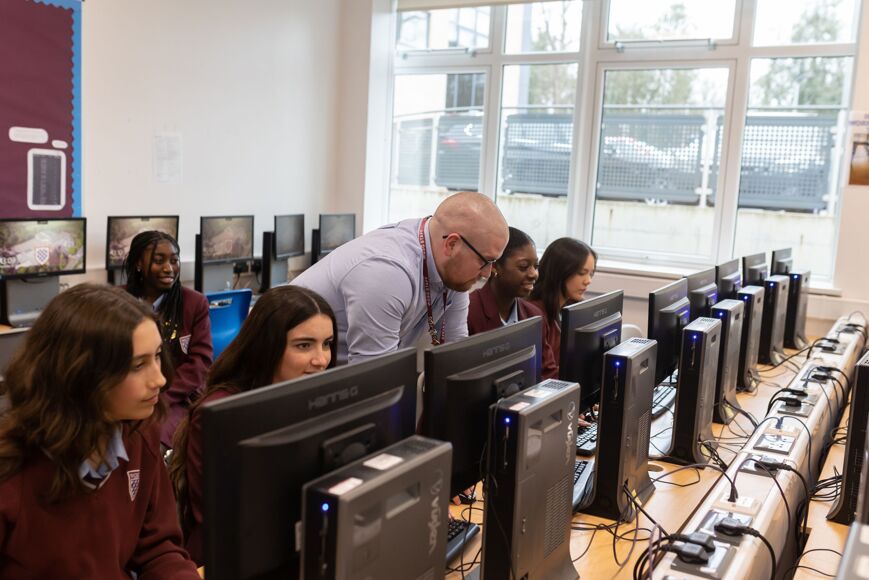COMPUTER SCIENCE

Department vision
In a world of ever-growing technology, Computer Science has become an important part of any young person’s learning, whether to help them to understand the basic concept of using a computer or stretching their knowledge further into programming skills and being able to understand the ins and outs of how a computer actually works.
In the Computer Science department at WGSG, we aim to follow a “practical” approach to Computer Science. This means that rather than just learning different topics for the sake of learning, students will gain valuable knowledge of how those topics relate to and are used in the “real world”. This allows students to get a wide range of knowledge needed to be successful in the future whether they go all the way to A Level with computer science or stop their journey at the end of Year 9.
Year 7
Year 7
In Year 7 will be exposed to the basic fundamentals of computer science, including the basics of using a computer (including how to send a professional email, and using key software such as MS Office) and then also an introduction to Programming with HTML and looking into how computers understand all information with Binary.
| Term 1 | Using a Computer / E-Safety |
| Term 2 | Binary |
| Term 3 | HTML / CSS |
| Term 4 | Spreadsheets |
| Term 5 | Hardware / Software |
| Term 6 | Interactive App |
Year 8
Year 8
In Year 8, students will build upon some knowledge from Year 7, looking into more detail about Binary, and doing some more advanced website building, along with this, students will also get an introduction into the main Programming language used right up to Year 11, Python. With students beginning Python programming now, by the time they get to GCSE’s the hope is that they will be confident in their programming ability.
| Term 1 | The Internet |
| Term 2 | Binary |
| Term 3 | HTML / CSS / JavaScript |
| Term 4 | Python |
| Term 5 | Storage |
| Term 6 | Network Security / Encryption |
Year 9
Year 9
In Year 9, students will continue to build upon their Binary knowledge, including looking at Hexadecimals. Students will also increase their Python ability with more advanced techniques including learning how to apply programming knowledge to make a bigger program (such as calculators etc). Alongside this, students will investigate further into how a computer actually works, looking at Operating Systems and how networks are set up.
| Term 1 | Python / Algorithms |
| Term 2 | Binary / Hexadecimal |
| Term 3 | Hardware / Networks / Topologies |
| Term 4 | Systems Software |
| Term 5 | Python |
| Term 6 | Software / Image Editing |
Years 10 & 11
GCSE
Computer Science is an option choice at GCSE level, and we follow the OCR Computer Science (J277) course. This course encourages students to develop their understanding and application of the core concepts in computer science. Students also analyse problems in computational terms and devise creative solutions by designing, writing, testing, and evaluating programs. It also encourages students to work on problem solving skills.
The course currently consists of 2 exam papers which hold 50% of the course each. Paper 1 focuses on the theory side of Computer Science, looking into the likes of networks, systems software, and binary. Paper 2 consists of programming concepts. We ultimately use Python as the programming language learnt to aid with the teaching of this paper.
Post 16 at WG6
A Level:
Computer Science is an option choice for A-Level. It is a full 2-year course, and we follow the OCR Computer Science (H446) course. This qualification helps students understand the core academic principles of computer science. Classroom learning is transferred into creating real-world systems through the creation of an independent programming project. This course will develop the students technical understanding and their ability to analyse and solve problems using computational thinking
The course currently consists of 2 exam papers and a programming project. Each paper is worth 40% of the qualification and the programming project fills the final 20%. Similar to the GCSEs Paper 1 is more about the theory of computer science and Paper 2 is about programming concepts. The programming project follow similarly to a real-world project in which students will need to plan, design, develop, test and evaluate a whole program created from scratch.



